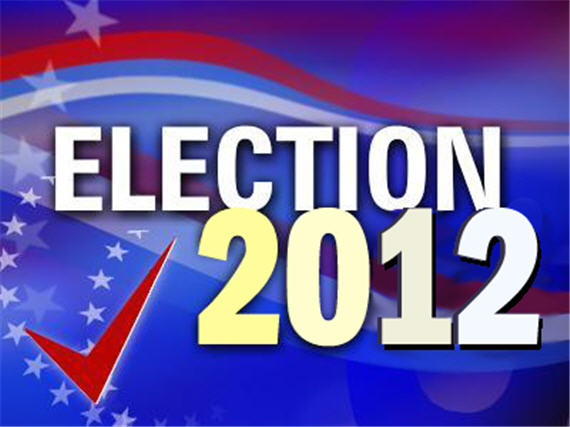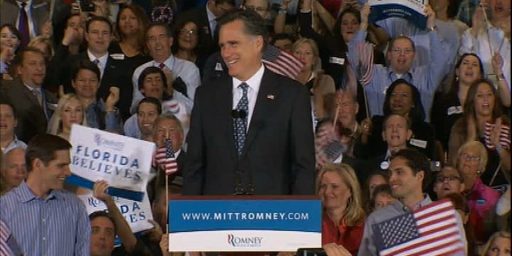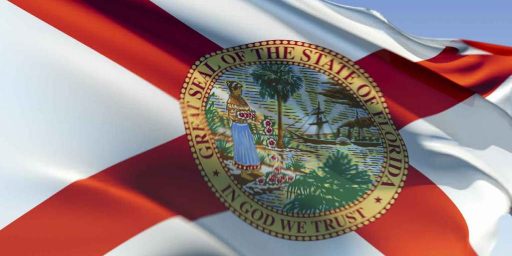Obama Leading Romney And Gingrich In Florida And So. Carolina?
A lesson in why the topline poll numbers are often only the beginning of the puzzle.
Yesterday I made note of the new NBC/Marist polls of South Carolina and Florida which showed Newt Gingrich with a huge lead over his Republican rivals. The other part of those polls that have some people raising their eyebrows dealt with head-to-head matchups in both states:
Turning to the general election, President Obama’s standing has improved in Florida, always a key presidential battleground state.
Forty-six percent of registered voters in the state approve of his job, which is up five points since October.
In hypothetical match-ups, the president leads Romney by seven points (48 to 41 percent) and Gingrich by 12 points (51 to 39 percent).
In South Carolina — a reliable Republican state in presidential contests — Obama’s approval rating stands at 4
4 percent, and he holds narrow leads over Romney (45 to 42 percent) and Gingrich (46 to 42 percent).
The idea that Barack Obama is leading in a head-to-head poll in Florida isn’t necessarily surprising. After all, he won the state by some 250,000 votes in 2008 and still has strong support in the voter-rich areas around Miami and Palm Beach County. The South Carolina numbers, however, are a surprise. After all, John McCain won that state by some 230,000 votes, a margin of nearly ten percentage points. Moreover, South Carolina has only gone for a Democratic Presidential candidate twice in the past fifty years, in 1960 for John F. Kennedy, and in 1976 for Jimmy Carter.
So what’s going on in the Palmetto State? An Obama surge? A weak Republican field? One explanation may be less-than-accurate polling.
If you take a look at the internals of the South Carolina Poll [PDF], you see this:
- 33% self-identified Democrats
- 36% self-identified Independents
- 30% self-identified Republicans
The 2008 exit poll for South Carolina shows us that the electorate that year looked like this:
- 38% self-identified Democrats
- 20% self-identified Independents
- 41% self-identified Republicans
In the 2010 elections, the South Carolina exit poll showed this:
- 35% self-identified Democrats
- 23% self-identified Independents
- 43$ self-identified Republicans
There are discrepencies between the Marist Poll and the exit polls in other demographic areas as well, most notably age, but this one provides the starkest example of what looks for all the world like a sample that is simply not reflective of the South Carolina electorate as a whole.
There are similar problems in the Florida Marist Poll.
The internals of the Marist Poll itself [PDF] show this:
- 44% self-identified Democrats
- 22% self-identified Independents
- 33% self-identified Republicans
The 2008 exit poll showed this:
- 37% self-identified Democrats
- 29% self-identified Independents
- 34% self-identified Republicans
The 2010 exit poll showed this:
- 36% self-identified Democrats
- 29% self-identified Independents
- 36% self-identified Republicans
Again, we’ve got what appears to be a sample that isn’t reflective of the likely Florida electorate, suggesting that the poll results themselves aren’t entirely reliable.
Is it possible that President Obama will end up winning Florida again in 2012? Certainly it is, in fact its pretty clear that he cannot win re-election without winning at least two states out of the group consisting of Ohio. Pennsylvania, and Florida. However, we’re going to need more polling before we accept these Marist numbers as anything other than a bad fluke.
As for South Carolina, that one I don’t believe. It’s been 35 years since a Democrat won the Palmetto State. LBJ couldn’t do it in 1964. Bill Clinton couldn’t do it. Obama wasn’t able to do it in 2008. Absent the kind of landslide re-election that seems incredibly unlikely, I doubt it will happen in 2012.







Alternate theory for Florida: You’re basing your criticism of the Marist poll based on 2010 exit poll party identification. Consider that the governor and his policies and his baggage is so toxic and divisive and with an astonishingly high disapproval rating, that he actively drives people away from the party and convinces them that voting for a Republican for President is a bad idea.
Call it the Rick Scott Effect.
Look at the exit polls for both 2008 and 2010. The polling demographics still don’t track
who cares? President obama will be easily re-elected without winning South Carolina.
Why not put effort into reality and look at how a Gingrich nomination will put Rep. Pelosi back into the Speakers chair and will allow the Democrats to expand their majority in the Senate.
Once again, what the Republicans are refusing to do is to decide how to overcome the failure, stupidity, and short-sightedness of the Bush Administration. Until the Republicans decide to throw Bush and anyone involved in governing from 2001 to 2008 under the bus, the problems for the Republicans will continue.
@Doug Mataconis:
I don’t understand. It seems like you’re saying that party identification cannot change over time.
When you’re constructing a Likely Voter model, the demographic breakdown from previous elections is the best guide you have. Otherwise you’re just guessing at who a LV is and you’re polling is worthless.
@Doug Mataconis:
Look closer.
The questions about age/race/etc in the Florida poll are being asked to all respondents.
The questions about voting preferences are only asked to registered voters.
15% of the respondents in the poll aren’t registered voters.
(And then there’s the fact that the ranges for ages aren’t the same in the CNN exit poll as in the NBC/Marist poll.
Or the fact that the demographics in 2008 and 2010 differs quite a bit.)
On Saturday you were all over a poll that had bad news for Obama (it showed his approval level steady, and a statistical blip in his handling of the economy)…today a poll that shows good news for Obama must be flawed.
Your partisan views are clear.
Perhaps you and Herman Cain could package yourselves in a deal for Fox News.
@Hey Norm:
The polling internals of that CBS polls aren’t as badly skewed as the Marist poll. Of course when there’s a poll that has bad news for Obama people like you dismiss so, you know, you’re partisan biases are the ones that are rather obvious.
@Doug Mataconis:
If you had based your LV-model for the 2010 election on the 2008 exit polls, then you would have seriously underpolled elderly voters and overpolled young voters and the polling would have been worthless. Same goes for basing your 2012 LV-model on the 2010 election.
And your polling would have been worthless, which is why pollsters update their LV-models.
Shorter Doug:
I don’t like Obama.
Yes Doug…it’s true…you caught me…I believe Obama is a better man for the job than any of the alternatives being offered….and I believe based on his record of accomplishments.
But the point is that you transparently glom onto any inkling of bad news and ignore any positive news.
For instance the strongest Black Friday/Cyber Monday in years got no mention on this blog…except from a couple commenters. Yet minor changes in some of the CBS polling frimly established that “Bad Economic News Spelling Bad News For POTUS”.
Or when the monthly employment numbers come out you almost always fail to mention that shrinking the Government and slashing public sector jobs are offseting 21 straight months of private sector gains.
But most importantly I’m not writing posts…I’m simply an un-compensated commenter. OTB claims to be “…an online journal of politics and foreign affairs analysis…” What you are doing with your choices of material fails to clear the bar of analysis…it’s just partisan hackery. And trying to justify it by dreaming up some false equivilancy between our cyber-roles is just weak on your part.
“…and I believe that based on his record of accomplishments…”
Hey Norm,
And because of that belief you always seem to find a way to reject any news that is potentially bad for the Messiah in the White House
I see Obama losing states like NV, IA, ID, VA, and NC. He might lose CO, NM, and MO. But all of this leaves the same as before – the Republicans need to win Ohio.
So how does the Newt v. Obama and Mitt v. Obama stack up in Ohio???
Anything else is just academic.
Cheers.
@Doug Mataconis: “Messiah” !?!?
Really!?
@Doug Mataconis:
Okay, I get where you’re coming from now.
But why wouldn’t you base a poll on the latest party self-identification splits rather than something from the last election? Not that I’m saying that Marist did this or not, I don’t know. (The minutia of polling defeats my patience; whenever I try to read Nate Silver, after about two minutes I just get tl;dr and click over to something else.)
The Rick Scott Effect thing I threw out was mostly for snarkiness, but intuitively (to me, at least) there may be a nugget of truth there. A terribly unpopular official can change both party identification in their area and also affect Independents’ voting preference.
@ Doug…
No…I look at his failures in context. For instance, the economy is growing really slowly…we just hired our first new employee in 3 years, after laying off 35% of the firm…but when you consider that the opposition is only offering the same tired old supply-side economics that have been tried and failed…slow is clearly better than the alternative. If I had my way, we would have single payer health care. But the ACA is the best we could do for now…and it’s a f*** lot better than the alternatives being offered. If I had my way we never would have escalated Afghanistan. But considering the opposition party couldn’t finish what they started I suppose it’s better than the alternative. I have plenty of problems with Obama…but there is no alternative.
But beyond that…your sulking response says it all.
@de stijl:
Yes it’s possible that there will be changes from one election to another, but the point is that the numbers in the Marist poll are so far off from historical norms, especially in South Carolina, that it calls their numbers into question. If other polls with different voter models say something similar, then we may have something. Right now, though, the most that can be said is that these numbers exist but that they ought to be taken with a grain of salt.
@PogueMahone:
Could there also be a John Kasich Effect?
@Doug Mataconis:
Actually, that really is not true. The best guide you have as to who will be voting is to ask people a few pointed questions regarding their interest in the next election.
That is why “likely voter” screens are less and less relevant the further away from an election that you get. And it is one of the reasons why outfits like Rasmussen who always use likely voter screens – end up with consistently skewed results.
No, you ask them. But this far out from an election, their answers would not be reliable. So you do registered voter surveys instead.
I agree with those who point out the changing reality of partisan alignment. Many people shift their self identification whenever they decide to support a candidate of a different party. And we know that happens a fair amount. I don’t know why you assume that partisan alignment is an unchanging standard against which candidate preferences are to be measured. They both change over time.
@Doug Mataconis:
The SC numbers are hinky. Which is why I ignored SC in my initial comment. Why wreck a perfectly elegant, half-assed theory with contradictory evidence?
Dude, you’re totally harshing my point-scoring ; – )
Sure thing bithead. Oh, wait that was Doug. Kind of hard to tell the difference.
Here are the numbers according to the Florida Division of Elections:
Democrat: 41%
Republican: 36%
Minor Party: 3%
None: 22%
http://election.dos.state.fl.us/nvra/affiliation.asp
Looks like Marist has a fairly accurate ssample.
Best leave peering into these polling numbers to wingnut polling experts like former call center drone Special Ed at Hot Air.
Doug,
“And because of that belief you always seem to find a way to reject any news that is potentially bad for the Messiah in the White House.”
We’ve got a screen here just for you. You already have the projection down pat.
Just saying…..who can be fairly considered to be longing for a messiah? Liberals trying to get their guy a second term or libertarians wishing that Gary Johnson wasn’t the Rodney Dangerfield of the Republican party?
And since the demographics in the Florida poll is based on all respondents, those can be compared with the 2010 Florida Census. (Rather than the 2010 exit poll which, obviously, is based on those voting.)
Here’s race (Excel file):
(First number is from the census, second from the poll)
White 62.0% 64%
Black 14.2% 13%
Hispanic 21.1% 18%
Other 4% 5%
Pretty accurate, except for the hispanics, but unless the GOP candidate picks Rubio for the VP slot, I doubt that’s a group who will end up voting for the Republican candidate.
(More polls like this and they will have to pick Rubio.)
And here’s age (Another Excel file):
(And again, first number from the census, second from the Marist poll)
18-29 19.7% 18%
30-44 23.9% 23%
45-59 26.6% 27%
60+ 29.7% 33%
I’d call those pretty accurate too, unless someone is going to argue about 18-29 being undersampled and 60+ being oversampled.
And for the South Carolina poll, here’s the 2010 census compared to the poll: (Excel file)
White 66.7% 68%
Black 26.3% 27%
Hispanic 4.3% 3%
Other 2.2% 3%
couldn’t find any good source for age.
And yet again, there’s nothing wrong with demographics in the polls, as long as you understand what they were based on and what they should be compared to.
@Doug Mataconis:
Aah, Doug, I wish you hadn’t said that. You know, I wish we could nominate Jon Huntsman for the candidacy, but you and I know that the current GOP has completely flipped out; no one wants to “take orders from the Black man in the White House.” “He’s not my president.” And so forth.
There’s no sanity in what once was a good party; only chaos. It’s not inconceivable that more people are seeing today’s GOP for what it is and changing their minds. We did it in 2008.
Nate Silver has already shown that turnout by party affiliation explains the difference between 2008 and 2010 election. The 2010 election was smaller turnout (off year always is) and Dem turnout was lower than normal and rep turnout was higher. If the Dems had turned out at the same level as 2008, even if the repub had also turned out at 2010 numbers, the Dems would have held the House (although lost seats).
Manipulating the party numbers is the easiest way to skew a poll result. Rassmusan lives on this, perfectly good polls that in every case over estimates likely republican voters and results in republican biased results. The problem is whenever you shift from all voters (pretty straight forward from census data) to likely voters. All kinds of shenanigans can be introduced.
Nate also looked at how accurate pre-election polls in general are. Not surprising the ones the weekend before election day were highly accurate. Any ones before Feb were completely worthless. It was pretty much a straight line from worthless in Jan to completely accurate just before election day, every week that goes by, the polls get better.
But not before Feb. Before Feb polls have virtually no correlation with final results. As in they are purely fiction. So pop the corn and enjoy the show but dont take them seriously.
I saw a poll last week, maybe at ppp… voters are leaving both parties officially. Lobbyists are more popular, politicians are dead last in a field of 20 or so, and they have a 7% favorable rating now.
@Hey Norm: You are delusional and have not been paying attention. Move to Venezuela where your communist dreams can come true.